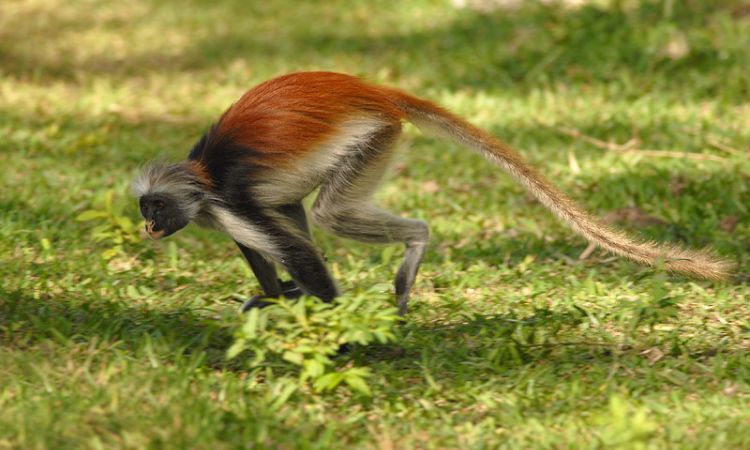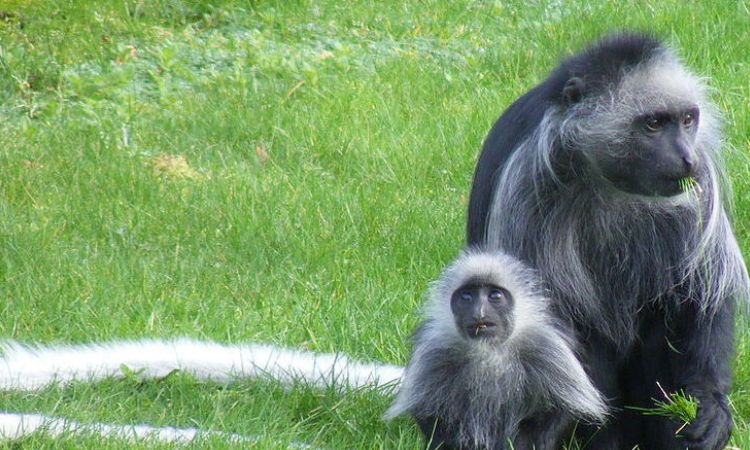8 Intriguing Facts about a Colobus Monkey You Didn’t Know
Discover fascinating facts about the colobus monkey – a leaf-eating primate with no thumbs and a leaping style like no other!
The colobus monkey, a striking primate native to Africa, captivates with its unique appearance and intriguing behaviors. Known for their glossy black-and-white or red fur and lack of thumbs, these arboreal creatures swing gracefully through the forest canopy.
Colobus monkeys are not just visually distinctive but also play a vital role in their ecosystems. This guide dives deep into their world, exploring their species, habitat, behavior, diet, and conservation challenges.
Colobus Monkey Scientific Name
The scientific name for colobus monkeys varies by species within the genus Colobus (black-and-white colobus) and Procolobus (red colobus).
For example, the guereza colobus is Colobus guereza, the Angolan colobus is Colobus angolensis, and the black colobus is Colobus satanas.
Red colobus species, such as the Tana River red colobus, are classified as Procolobus rufomitratus. The term “colobus” derives from the Greek word for “mutilated,” referring to their lack of thumbs.
These scientific names help researchers identify and study their unique adaptations and conservation needs across African forests.
Colobus Monkey Species
Colobus monkeys belong to the genus Colobus and are primarily divided into two main groups: black-and-white colobus and red colobus.
The black-and-white colobus includes species like the Angolan colobus (Colobus angolensis), the guereza (Colobus guereza), and the black colobus (Colobus satanas).
These monkeys are characterized by their contrasting fur patterns, with long, white tail tufts and facial fringes. Red colobus species, such as the Tana River red colobus (Procolobus rufomitratus), sport reddish-brown coats. Each species has adapted to specific regions and forest types across Africa, showcasing remarkable diversity within the genus.
Red Colobus Monkey
Red colobus monkeys, genus Procolobus, are vibrant primates with reddish-brown fur, found in African forests from Senegal to Zanzibar.
Species like the Tana River red colobus (Procolobus rufomitratus) and Zanzibar red colobus (Procolobus kirkii) live in rainforests, swamps, and coastal forests.
They are folivores, eating leaves and fruits, with specialized stomachs for digestion. Social groups can include up to 80 individuals, with complex grooming and vocal behaviors.
Many red colobus species are endangered due to deforestation and hunting. Conservation efforts, like protected reserves, aim to safeguard their habitats and ensure their survival.

Black-and-White Colobus Monkey
Black-and-white colobus monkeys, genus Colobus, are known for their striking fur patterns, featuring glossy black coats with white facial fringes or tail tufts.
Species include the guereza (Colobus guereza), Angolan colobus (Colobus angolensis), and black colobus (Colobus satanas).
Found in African rainforests and montane forests, they are arboreal, leaping gracefully between trees. Their thumb-less hands aid in brachiation, and their leaf-based diet supports forest ecosystems.
Living in small groups, they communicate through roars and purrs. Habitat loss threatens their populations, making conservation critical to their survival.
King Colobus
The King colobus (Colobus polykomos), a black-and-white colobus species, is native to West African rainforests, from Sierra Leone to Côte d’Ivoire. Known for its glossy black fur and white facial whiskers, it lacks thumbs, aiding its arboreal leaps.
Weighing 15–22 pounds and measuring 20–27 inches, it lives in small groups of 3–15, led by a dominant male. Its leaf-based diet is digested by a specialized stomach.
Vocalizations, like roars, mark territory. Threatened by deforestation and hunting, the King colobus is vulnerable on the IUCN Red List, requiring urgent conservation efforts.

Where Are Colobus Monkeys Found: Colobus monkey habitat
Colobus monkeys inhabit African forests from West to East Africa. Black-and-white colobus, like the guereza , are found in Ethiopia, Kenya, Tanzania, and Uganda’s rainforests and montane forests.
The Angolan colobus lives in Central African forests, including the Congo Basin. The King colobus resides in West African rainforests, from Sierra Leone to Côte d’Ivoire.
Red colobus, such as the Zanzibar red colobus, are endemic to Zanzibar’s forests, while the Tana River red colobus occupies Kenya’s riverine forests. Habitat loss threatens all populations.
Physical Characteristics of a Colobus Monkey
Their most striking feature of colobus monkeys is their fur: black-and-white colobus have bold, monochromatic patterns, while red colobus display vibrant reddish hues.
A defining trait is their lack of thumbs, an adaptation that aids in brachiation (swinging between branches). Their long tails provide balance during leaps, and their lightweight bodies allow them to navigate the canopy with ease.
Visual aids like photos of a guereza’s flowing white mantle or a red colobus’s fiery coat can enhance understanding of their beauty.
Colobus Monkey Size
Colobus monkeys are medium-sized primates, with body lengths of 18–27 inches and tails nearly as long, measuring 20–30 inches. They weigh 10–30 pounds, with males slightly larger than females.
Black-and-white colobus, like the guereza (Colobus guereza), tend to be larger than red colobus species, such as the Zanzibar red colobus (Procolobus kirkii).
Their lightweight bodies and long tails aid in leaping through forest canopies. Size variations depend on species and habitat, with larger individuals often found in denser forests where food is abundant. Their compact size supports their arboreal lifestyle.
Colobus Monkey Behavior and Social Structure
Colobus monkeys are highly social, living in groups of 5–15 individuals, though some red colobus groups can number up to 80. These groups typically consist of one or two adult males, several females, and their offspring. Social bonds are reinforced through grooming, which strengthens group cohesion.
Their communication includes vocalizations like roars, chutters, and purrs, often used to signal territory or alarm. Body language, such as facial expressions and postures, also plays a key role. Colobus monkeys are diurnal, spending their days foraging and resting in the treetops, rarely descending to the ground.
Colobus Monkey Diet and Feeding Habits
Colobus monkeys are folivores, meaning their diet primarily consists of leaves. They favor young, tender leaves but also eat mature leaves, buds, flowers, and occasionally fruits.
Their specialized, multi-chambered stomachs, similar to those of cows, allow them to digest tough cellulose in leaves. This adaptation enables them to extract nutrients from foliage that other primates cannot.
They spend much of their day foraging, selectively choosing leaves high in protein and low in toxins. Their diet makes them vital seed dispersers, contributing to forest regeneration.
Reproduction and Lifespan of a Colobus Monkey
Colobus monkeys have a polygynous mating system, where dominant males mate with multiple females in the group. Females initiate mating through specific behaviors, such as presenting themselves to males.
After a gestation period of about 5–6 months, a female gives birth to a single infant, which is born with a lighter coat that darkens with age.
Infants are cared for by the mother and other group members, a behavior known as alloparenting. In the wild, colobus monkeys live about 20 years, though they can reach up to 30 years in captivity with proper care.

Colobus Monkey Baby
Colobus monkey babies are born after a 5–6-month gestation period and are strikingly different from adults. Black-and-white colobus infants have white or pale fur, which darkens as they mature, while red colobus babies have lighter reddish coats.
Weighing about 1–2 pounds at birth, they cling to their mothers for safety and nursing. Alloparenting, where group members help care for the young, strengthens social bonds.
Infants begin eating leaves within months but remain dependent for up to a year. Their vulnerability highlights the need for habitat protection to ensure safe environments for growth.
Are Colobus Monkeys Intelligent?
Colobus monkeys exhibit moderate intelligence suited to their arboreal lifestyle. Their social structures, with groups of 5–80, require communication through vocalizations, facial expressions, and grooming, indicating social intelligence.
They navigate complex forest canopies, showing spatial awareness and problem-solving in foraging for leaves. While not as advanced as apes in tool use or abstract reasoning, their ability to adapt to diverse forest environments and maintain group cohesion suggests cognitive competence.
Research on primate intelligence is limited for colobus, but their behaviors reflect practical intelligence for survival in challenging habitats.
Are colobus monkeys endangered?
Colobus monkeys face significant threats from habitat loss due to deforestation, agricultural expansion, and logging. Hunting for their fur, once used in ceremonial garments, and bushmeat trade also pose risks.
The IUCN Red List classifies several species as vulnerable or endangered, with the Tana River red colobus among the most critically endangered due to its limited range.
Conservation efforts include protected areas like national parks and reserves, reforestation projects, and community education programs.
Organizations like the African Wildlife Foundation work to safeguard colobus habitats, but ongoing challenges require global support.
Colobus monkey fun facts
- Ceremonial Fur: Historically, colobus fur was used in African ceremonial garments and even traded as far as Europe for clothing.
- Leaping Legends: Colobus monkeys can leap up to 20 feet between trees, using their long tails for balance.
- Vocal Performers: Their loud, roaring calls can be heard over a mile away, especially at dawn.
- Thumb-less Wonders: Their lack of thumbs is a unique adaptation, making their hands more hook-like for swinging.
FAQs About Colobus Monkeys
Are colobus monkeys endangered?
Some species, like the Tana River red colobus, are critically endangered, while others are vulnerable due to habitat loss and hunting.
Do colobus monkeys have thumbs?
No, colobus monkeys lack thumbs, an adaptation that aids their arboreal lifestyle by improving their grip on branches.
How long do colobus monkeys live?
In the wild, they live around 20 years, but they can reach up to 30 years in captivity.
Where do colobus monkeys live?
They inhabit African forests, including tropical rainforests, montane forests, and coastal areas from West to East Africa.
What do colobus monkeys eat?
Their diet is mainly leaves, supplemented by buds, flowers, and occasional fruits, digested by their specialized stomachs.
